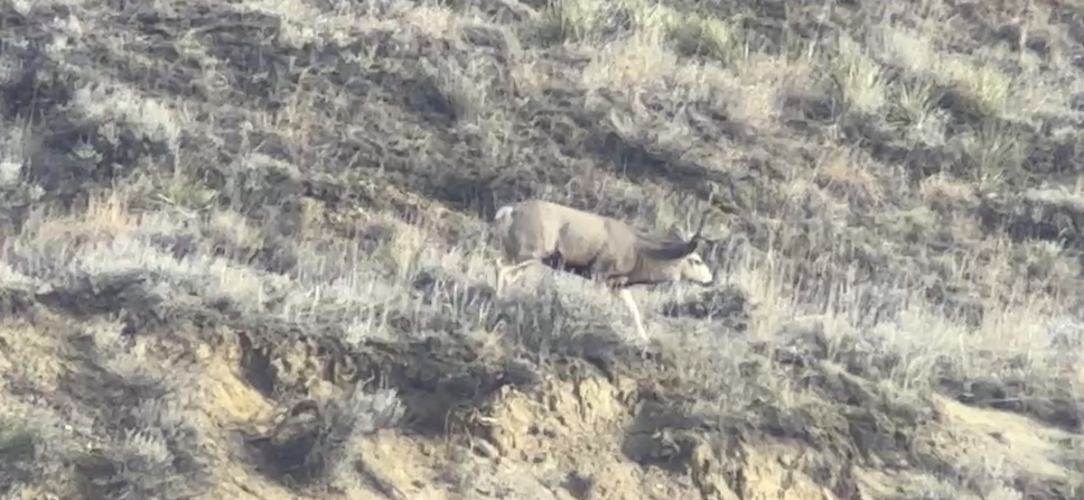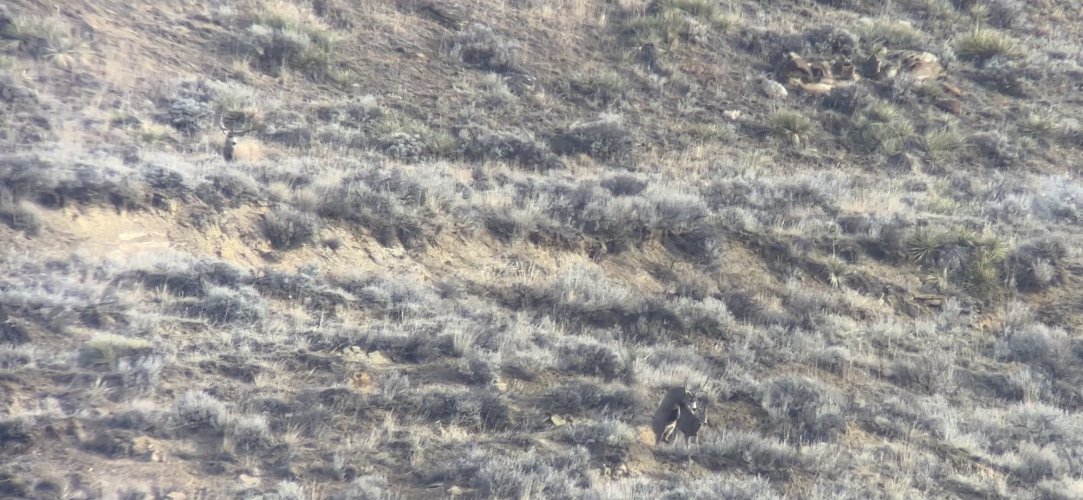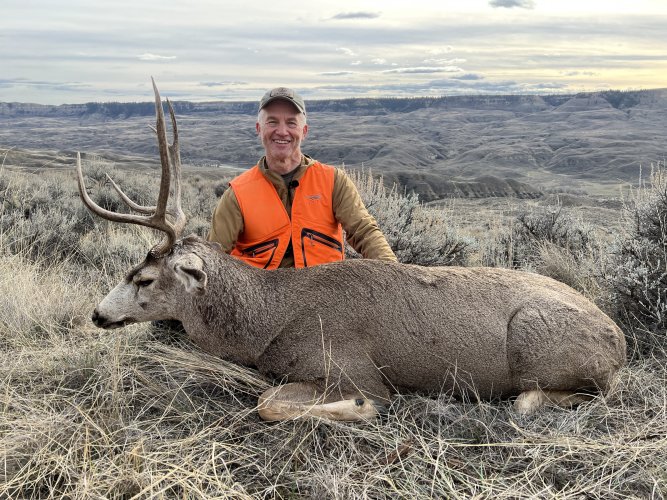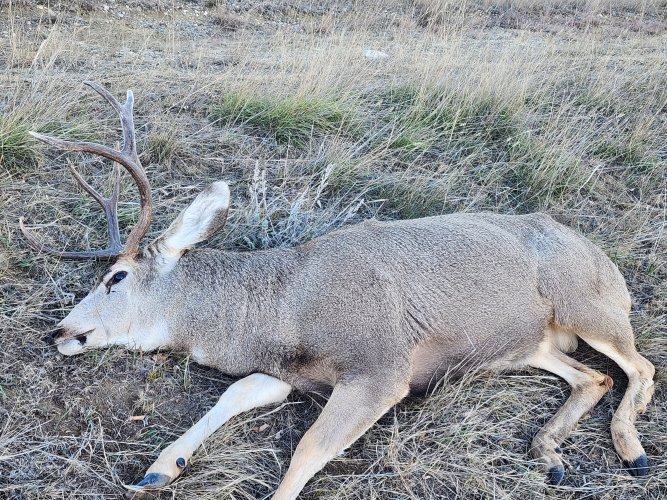I have seen an area burnt straight to the ground with B tags. Fwp disputes this fact, but that is exactly what happened. 11k doe tags distributed throughout the region could be a drop in the bucket. 11k doe tags where the North Dakotans find a high deer density and reasonable access and numbers can look much different in 2-5 years at 7 tags a person. When numbers are below the LTA why even give them at all. Mother Nature controls the population according to FWP. We can’t control Mother Nature. We aren’t saving deer by shooting them.
Navigation
Install the app
How to install the app on iOS
Follow along with the video below to see how to install our site as a web app on your home screen.
Note: This feature may not be available in some browsers.
More options
You are using an out of date browser. It may not display this or other websites correctly.
You should upgrade or use an alternative browser.
You should upgrade or use an alternative browser.
Montana Mule Deer Mismanagement
- Thread starter rogerthat
- Start date
Laszlo Cravensworth
Well-known member
They did in 2021, which was when the drought hit. The fawns would have been born in 2022. Sorry, I could have been more clear.
Look it is probably legit from a biological point of view to say a reduction of the herd would have been compensatory and probably helped the survivors, but this is where messaging gets messy. Most hunters are not going to agree with cutting a ton of does even though food is scarce. Especially given it will tank deer hunting for a few years forward.
I've sort of soured on compensatory take. It feels like it's touted more as an excuse for opportunity than herd health anymore.
There are a lot of variables in winter kill that contribute to whatever poor confidence interval they share. Why would we expect that the doe that may be more likely to be killed by a hunter is the same doe that is likely to die of winter kill?
rogerthat
Well-known member
- Joined
- Aug 29, 2015
- Messages
- 3,132
I think it probably depends on the area. Some areas have very limited winter range. Montana Region 7 is not one of those areas. I’m not sure it applies whatsoever in region 7I've sort of soured on compensatory take. It feels like it's touted more as an excuse for opportunity than herd health anymore.
There are a lot of variables in winter kill that contribute to whatever poor confidence interval they share. Why would we expect that the doe that may be more likely to be killed by a hunter is the same doe that is likely to die of winter kill?
SAJ-99
Well-known member
Your comment demonstrates a large part of the core problem. Schaaf pointed out, FWP has certainly lost credibility with the 40% of hunters that want a quality hunt if not more. Opportunity is obviously the primary objective and as Ben Lamb has pointed out revenues from those tags is material. I'm just saying that in 2021 announcing they were proactively cutting B tags from 11,000 to 8,000 due to drought (even though that is not the correct action when looking at the model) might have helped with that eroding-credibility problem. I would agree that some people are just gone. FWP could give them everything they ask for and it won't change their view.I've sort of soured on compensatory take. It feels like it's touted more as an excuse for opportunity than herd health anymore.
There are a lot of variables in winter kill that contribute to whatever poor confidence interval they share. Why would we expect that the doe that may be more likely to be killed by a hunter is the same doe that is likely to die of winter kill?
The fact that nature kills the the youngest, oldest, weakest, and less healthy while hunters are bragging about killing a "big" doe is not going to help our sport overall, but I get your point and agree.
WanderWoman
Well-known member
FWP actually removed the modeling component in the updated AHM Guidelines (pages 1 and 2). After 2001 it was unsuccessful in accurately predicting mule deer population trends so instead of relying on it in the latest version they moved it to research as development.This is great info. Thanks for sharing. Last winter showed us there is considerable variability in the survival rates. I saw some data from Wyoming range where 100% of collared fawns died, 70% of bucks, 60% of does. My main criticism of MT FWP is that the AHM isn't used in a predictive way. The model is changed only after getting new data that says things went into the tank. For example, if you know that 2021 was a bad drought year and you know deer are going into winter with low body fat and you know the will affect 2022 fawn numbers, why the hell give out 11,000 Region 7 B tags? I guess the argument could be "It's compensatory"?
Idaho has done some great work on population modeling based off the thousands of animals they’ve collared, and maybe some of what they found can be extrapolated to MT but only to a point.
Also found this while googling last night. Curious to see what they are finding. It’s rare to see ungulate studies focused on bucks because the general paradigm is ‘collar the females because they have the greatest impact to the population.’ Which is important. However I’d argue that the males warrant some additional study since it seems they’re what most stakeholders are interested in. That’s my assumption anyway.
https://idfg.idaho.gov/press/fg-collaring-mule-deer-bucks-get-better-look-long-term-survival
Last edited:
375H&H
Well-known member
Just less than half were on public.I suppose this was all on publicly accessible land too?
300stw
Well-known member
- Joined
- Jul 6, 2008
- Messages
- 879
Thank you for your serviceim working on the gene pool for you guys,,
doing my part,View attachment 302239
Good work.im working on the gene pool for you guys,,
doing my part,View attachment 302239
I did the same thing on Wednesday. I hadn't filled a deer tag since 2018, always looking for something I knew for certain was over 4.5 years, passing many chances on bucks I figured were 3.5 and maybe passed one or two that could have been older.
I shot the biggest-bodied 2x3 I've seen in Montana, but I was a little late in stopping his procreation. I had seen him Monday afternoon chasing off every other buck and holding onto a good batch of does. Not a single buck dared stand ground when they got in a stare down. He did more of the same on Tuesday, though I let him go since was looking for a whitetail. When he reappeared and demonstrated that same behavior on Wednesday morning I decided to shoot him, though he spent about three hours passing on his genetic code one last time in few hours it took for us to get in shooting position. I will get him aged at Matson's, as I suspect he is 5+ y/o.
It makes me wonder how many of these old forkie/3-points never get shot and are passed for younger 4 points that have the potential for better antler growth. The doe surely carries half of the genetics, but when most of the older dominant bucks are forkie/3-points, I suspect that selects for continuation of more forkie/3-points.
Of the 20+ bucks I saw, I think only three were true 4x4 and their body size made me think they were likely 3.5 year olds. I passed in hopes they'll make a couple more seasons and grow to be something better, but with the amount of hunters, even for mid-week, and how dumb these bucks were, it will take some exceptional good luck for them to get through season.
300stw
Well-known member
- Joined
- Jul 6, 2008
- Messages
- 879
i have honestly looked at , a minimum of 46 bucks the last 4 weeks, 2 real good ones, the buck my wife harvested, i have watched him for 3 years come to same rutting area, so i think he was 4.5, other people were on to him , she wanted to harvest him. end story.
i passed on 8 bucks today, 2.5 or 3.5 yr old 4 points,, didnt feel the need to havest them
we like deer meet, and try to be somewhat subjective on a harvest,
wifes buck provided 97 lbs of close trimmed meat including backstraps
this one probably one third smaller,,
im not disappointed, rattled 2 bucks in to 10 yards
but back to the thread, last year in 4 weeks, had almost 2x as many bucks spotted, not many does either,,,,
i passed on 8 bucks today, 2.5 or 3.5 yr old 4 points,, didnt feel the need to havest them
we like deer meet, and try to be somewhat subjective on a harvest,
wifes buck provided 97 lbs of close trimmed meat including backstraps
this one probably one third smaller,,
im not disappointed, rattled 2 bucks in to 10 yards
but back to the thread, last year in 4 weeks, had almost 2x as many bucks spotted, not many does either,,,,
cgasner1
Well-known member
- Joined
- Apr 24, 2016
- Messages
- 4,310
I stopped at the cwd check station today was the 3rd buck thru she said it’s been slow all season maybe this blue bird weather will help a few more make the year
antlerradar
Well-known member
I think there is correlation between really crappy hunting weather and a few better bucks the next year.I stopped at the cwd check station today was the 3rd buck thru she said it’s been slow all season maybe this blue bird weather will help a few more make the year
peterk1234
Well-known member
- Joined
- Oct 9, 2019
- Messages
- 755
Seen lots of does this year. We saw five big bucks on our way east this past week, all on private. They seem to be starting to show interest in the ladies. We we were going after whitetails on this particular trip. I had three muley bucks in range, all under two hundred yards. Middle of the day. All of them on the move. All three pointers. Nice to see them though. Maybe next year they will be bigger.
cgasner1
Well-known member
- Joined
- Apr 24, 2016
- Messages
- 4,310
I was thinking that on the way home. Let’s not say the quiet part out loudI think there is correlation between really crappy hunting weather and a few better bucks the next year.
Probably some truth to that. Less deer on public lands is fairly constant though. If a good buck popping up on public land every now and then is a management success then we are knocking it out of the park at the expense of our mule deer herd. Til it’s gone.I think there is correlation between really crappy hunting weather and a few better bucks the next year.
antlerradar
Well-known member
Not saying it is going to be great. If some of those 130 inch two year olds survive and turn into 150 inch three year olds it is going to look like Montana is the land of milk and honey to many.I was thinking that on the way home. Let’s not say the quiet part out loud
Knocking it out of the park for some, I would call it a two out broken bat bloop single with no one on base. Gets your hopes up, for a year but your are not likely to score.
Last edited:
Let’s see himI shot the biggest-bodied 2x3 I've seen in Montana, but I was a little late in stopping his procreation. I had seen him Monday afternoon chasing off every other buck and holding onto a good batch of does. Not a single buck dared stand ground when they got in a stare down. He did more of the same on Tuesday, though I let him go since was looking for a whitetail. When he reappeared and demonstrated that same behavior on Wednesday morning I decided to shoot him, though he spent about three hours passing on his genetic code one last time in few hours it took for us to get in shooting position. I will get him aged at Matson's, as I suspect he is 5+ y/o.
Dead or alive?Let’s see him
He's not happy about these younger bucks disrupting his work. Here he's on a march toward one of them, a nice buck that decided he wanted no part of this guy.

Seems he preferred an audience for his performances. A larger framed 3x4 is watching the debauchery from a bench about 50 yards above and to the left of this buck and his doe. That 3x4 thought he wanted some of the action, but was run off by this dude multiple times.

He and his doe were so distracted that when we got to 180 yards above them, they just stared at us as we watched them. I finally asked Michael to skyline himself and waive his hands, which got them to stand up.

I find it interesting that many of the dominant bucks in this area were configured like him as big 3x3 or 3x4. I doubt at his peak he was even a 150" buck. Wonder if he was ever a true 4x4. Guess it doesn't matter. I suspect Montana's season structures and heavy hunting pressure make younger 4x4 bucks the primary target and thus we see fewer of them get to the age of this guy.
I’ve seen some really big whitetails crossing the highway over there and those guys have plenty of time to huntThere are some good hunters on the Cheyenne, they are taking some good bucks.
Twenty five years ago there was a line of Cheyenne hunters headed to the Custer daily. I would be surprised if I have seen a half dozen this year. If all the locals quit going to a restaurant there is a reason, the same logic applies to hunting.
Irrelevant
Well-known member
The thing is, maybe his ma was in poor shape the year she had him, which has expressed itself in his lack of antler development. He might have spent years passing on good genes while hunters passed on him.Dead or alive?
He's not happy about these younger bucks disrupting his work. Here he's on a march toward one of them, a nice buck that decided he wanted no part of this guy.
View attachment 302407
Seems he preferred an audience for his performances. A larger framed 3x4 is watching the debauchery from a bench about 50 yards above and to the left of this buck and his doe. That 3x4 thought he wanted some of the action, but was run off by this dude multiple times.
View attachment 302408
He and his doe were so distracted that when we got to 180 yards above them, they just stared at us as we watched them. I finally asked Michael to skyline himself and waive his hands, which got them to stand up.
View attachment 302409
I find it interesting that many of the dominant bucks in this area were configured like him as big 3x3 or 3x4. I doubt at his peak he was even a 150" buck. Wonder if he was ever a true 4x4. Guess it doesn't matter. I suspect Montana's season structures and heavy hunting pressure make younger 4x4 bucks the primary target and thus we see fewer of them get to the age of this guy.
Last edited:
Similar threads
- Replies
- 4
- Views
- 688





